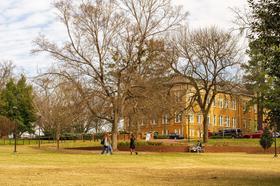Serving 331 students in grades Kindergarten-5, Franklin Elementary School ranks in the bottom 50% of all schools in Minnesota for overall test scores (math proficiency is bottom 50%, and reading proficiency is bottom 50%).
The percentage of students achieving proficiency in math was 35-39% (which was lower than the Minnesota state average of 46%). The percentage of students achieving proficiency in reading/language arts was 45-49% (which was lower than the Minnesota state average of 51%).
The student-teacher ratio of 13:1 was equal to the Minnesota state level of 13:1.
Minority enrollment was 49% of the student body (majority Black and Hispanic), which was higher than the Minnesota state average of 39% (majority Black and Hispanic).
Top Rankings
Franklin Elementary School ranks among the top 20% of public schools in Minnesota for:
Category
Attribute
Diversity
School Overview
Grades Offered
Grades Kindergarten-5
(No virtual instruction)
(No virtual instruction)
Total Students
331 students
Gender %
Total Classroom Teachers
25 teachers
School Rankings
Overall Testing Rank
#1043 out of 1773 schools
(Bottom 50%)
(Bottom 50%)
Math Test Scores (% Proficient)
35-39%
46%
Reading/Language Arts Test Scores (% Proficient)
45-49%
51%
Science Test Scores (% Proficient)
30-39%
41%
Student-Teacher Ratio
13:1
13:1
American Indian
1%
2%
Asian
6%
7%
Hispanic
11%
12%
Black
18%
12%
White
51%
61%
Hawaiian
n/a
n/a
Two or more races
13%
6%
All Ethnic Groups
Eligible for Free Lunch
55%
36%
Eligible for Reduced Lunch
12%
7%
School Statewide Testing
School District Name
Source: National Center for Education Statistics (NCES), MN Dept. of Education
Frequently Asked Questions
What is Franklin Elementary School's ranking?
Franklin Elementary School is ranked #1043 out of 1,773 schools, which ranks it among the bottom 50% of public schools in Minnesota.
What percent of students have achieved state testing proficiency in math and reading?
35-39% of students have achieved math proficiency (compared to the 46% MN state average), while 45-49% of students have achieved reading proficiency (compared to the 51% MN state average).
How many students attend Franklin Elementary School?
331 students attend Franklin Elementary School.
What is the racial composition of the student body?
51% of Franklin Elementary School students are White, 18% of students are Black, 13% of students are Two or more races, 11% of students are Hispanic, 6% of students are Asian, and 1% of students are American Indian.
What is the student-teacher ratio of Franklin Elementary School?
Franklin Elementary School has a student ration of 13:1, which is equal to the Minnesota state average of 13:1.
What grades does Franklin Elementary School offer ?
Franklin Elementary School offers enrollment in grades Kindergarten-5 (No virtual instruction).
What school district is Franklin Elementary School part of?
Franklin Elementary School is part of Anoka-Hennepin School District.
Recent Articles

Public School Transportation & Commute Planning Guide
Learn how public school transportation and commute planning can help families prepare for the coming school year safely and efficiently.

New Public School Safety Protocols 2025–26 Guide
Learn how new public school safety protocols for 2025–26 affect students, parents, and schools nationwide.

How Technology Transforms Education in 2025
Explore how technology shapes learning today, with updated data, policy context, trends, and real-world implications for students, educators, and families.





